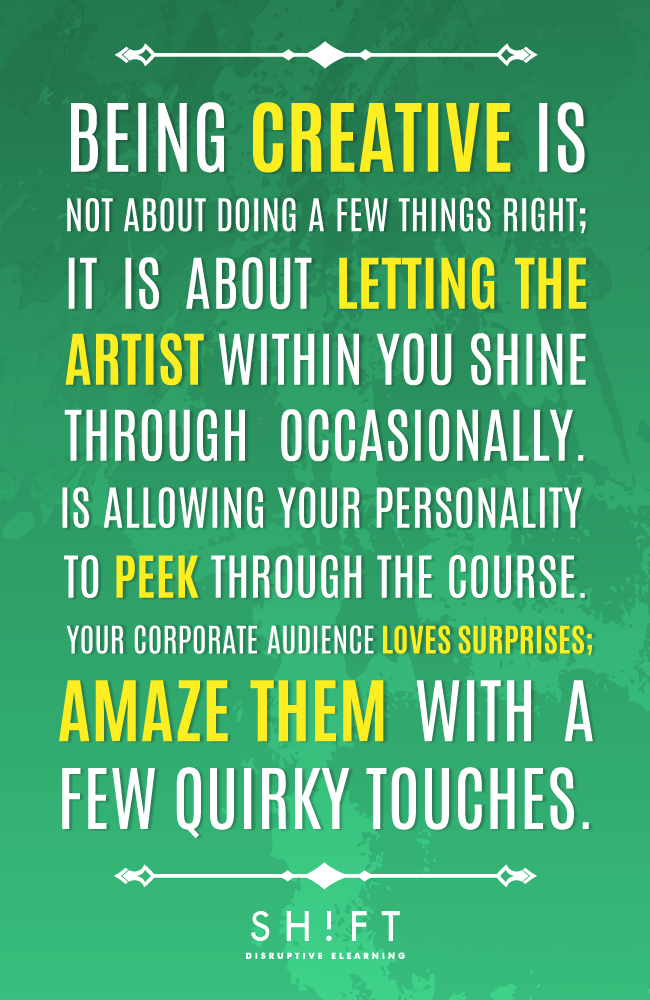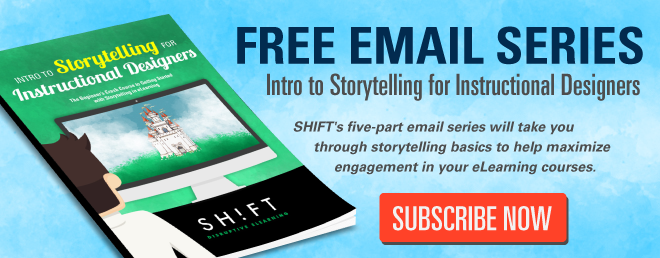It is true that we learn design principles from a bunch of theories. But too often, we eLearning designers make the mistake of relying on these theories to give us design ideas. They can provide ideas but only so much. You need to think beyond the theories and look around you to find inspiration and break free from the creativity rut.
Last week we published the first part of the Creativity Series. Here we will continue giving you more design hacks.

Hack 1: Create inspiration or "mood" boards
Ask any writer, painter, scientists, or innovator. They will all agree that they did not always sit hunched at their desks and stared at their notebooks or screens waiting for inspiration to strike them. Creative people derive their ideas and inspirations from their environments. They can connect the dots and find patterns in seemingly unrelated events. Imagine someone getting a brainwave when an apple fell on his head!
Interact with people, read more books and blogs, attend a variety of events, and be in the nature more often to find your inspiration.
Instructional designers, you can find your inspiration from a host of other apparently unconnected products and situations. Product packaging, the signs on the road, movies, plays, websites, video games, and children's toys—these can give you ideas on how to explain or demonstrate concepts, communicate represent abstract ideas, or convey instructions using images.
Carry your gamut of inspiring ideas around with you. But when you come to work, rely on an "inspiration" or mood board to help you ideate and innovate.
A mood board is where you (physically) pin your ideas, thoughts, and concepts. This mish-mash of text, drawings, photographs, screenshots from other courses or websites, and anything else that captures your imagination helps you find inspiration, connect ideas, and come up with quirky design solutions for your courses.
Here's how you can create an inspiration board that will become your creativity mojo:
- Create one mood board for every course.
- Browse the Internet or pore over books, brochures, and newspapers to look for anecdotes that best explain a concept that you intend to cover in your course. Jot it down or print it and stick it on the inspiration board, or even have it on pinterest.
- Search for infographics that deal with the subject matter in your course. Well-designed infographics are stellar examples of how text and images can be blended to present information in visually enticing and instructionally effective ways. Print (or pin) a few of these on the mood board to create your source of creative inspiration.
- Search for common themes in other eLearning courses and stick screenshots from these on the board.
An idea journal can also serve as your well of creativity. Jot down in the journal any great idea for a scenario, a quote that captures the essence of your course, or an analogy that you can build upon. When you get back to work, mull over what you have noted down to spot patterns, find inspiration, or branch off to form new ideas. A voice recorder, your iPhone, or post-it notes work equally well as reservoirs for your brainwaves.
Hack #2: Collaborate with other creative minds
Successful and prolific designers do not always pluck inspiration and ideas out of thin air. They glean their creative ideas from the environment and especially, by interacting with other creative souls as them. Many designers will advise you to surround you with creative people and lateral thinkers whose opinions you trust and who can inspire you when your creative juices dry up. Schedule meet-ups with fellow designers or co-rent a workspace with another freelance designer, so you can brainstorm ideas together.
Two heads are always better than one. So when you are short on the ideas, talking to other designers can help you see things in a different light, get you to think along new lines, improve upon your existing ideas with their constructive criticism, and create innovative eLearning solutions. These interactions are valuable learning experiences also because you get to know how another creative mind works. There is definitely strength in numbers!
Hack #3: Design, iterate, design
Even the greatest creative geniuses of our times don't get it right the first time! Apple didn't perfect the design of their notebooks till they had experimented with several prototypes. Result-centric creative people design, iterate, experiment, and design more.
Iteration is an integral part of creating great designs. It is a chain of constant refinement where you build upon and better your previous designs. The results from a previous round of iteration serve as the springboard for the next stage of design tweaks.
Iterations help you perfect your design skills and sharpen your intuition. The more you flex your creativity muscles, the stronger they become. You get to experiment at every round of the iterative process till you reach excellence. Iterations also help you create innovative and harmonious designs.
The process of iterative course design is ideal for complex tasks. You can assess a prototype at every state of iteration and modify or later the design as needed instead of tackling the complexities and trying to be creative at the same time. Designing, iterating, experimenting, and re-designing ensure you not only create the perfect design but also do not overlook details or slips and miss the fine print. The end result is a product that is useful for the audience, grabs the eyeballs, and keeps them hooked till the end.
Hack #4: Be fearless
Never fear to fail. Be courageous. Do not be afraid to experiment with your ideas. Flesh them out to see where they lead you to. If you fail, get up, pick up the pieces, find out the lessons, and keep moving. You do not have to go wild with every eLearning course you create, but do not also fall back on tried-and-tested solutions every time you are stuck. Be bold, and take that risk. Else you will never know what magic you could have weaved.
Recommended reads:

CONCLUSION:
Creativity is a mindset. It is a way of thinking and tackling change and the unknown. Being creative is not about doing a few things right; it is about letting the artist within you shine through occasionally. Being creative is allowing your personality to peek through the course. Your corporate audience loves surprises; amaze them with a few quirky touches.



